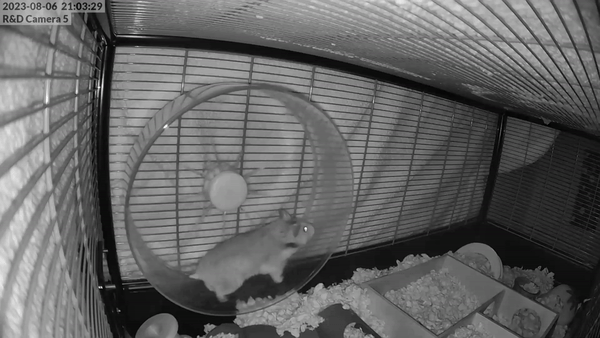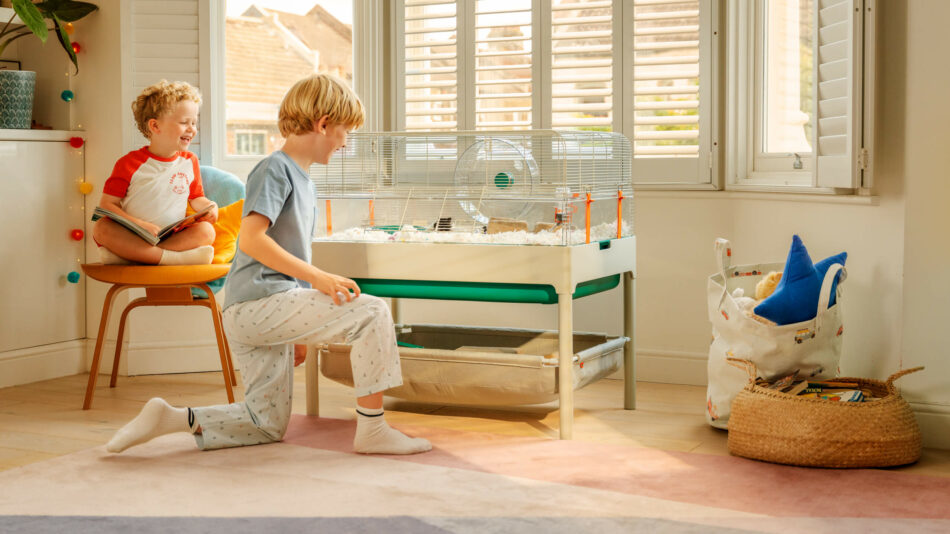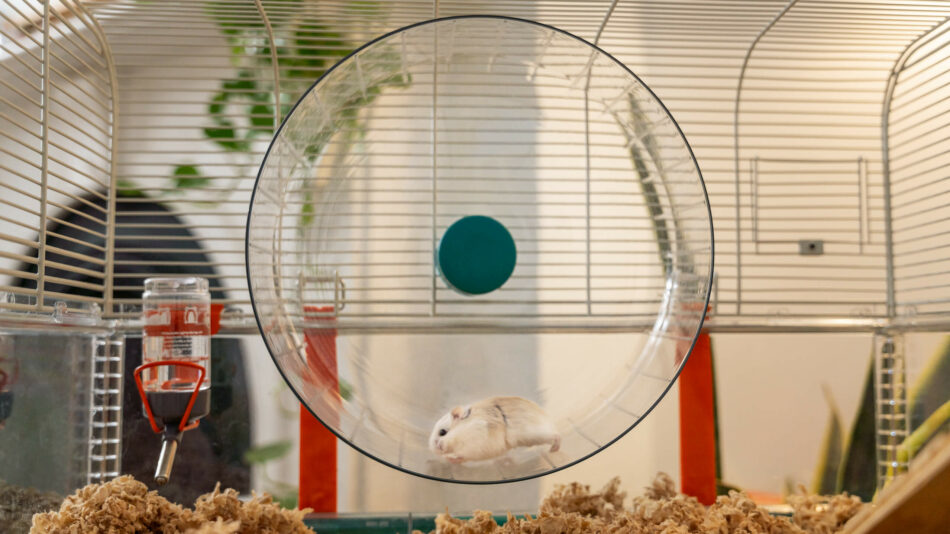Can we design hamster happiness?
An Omlet designer starts every project with a question: what will bring us closer to our pets? Then, we break that question down into many more. How do hamsters live in the wild? What makes a perfect hamster and human moment? What challenges do hamsters present as pets? These are a few of the questions we asked when we set out to create our new Hamster Habitat.
We found a perception of hamsters as “starter pets”; one you begin with in preparation for a more challenging one. We thought these intelligent, diligent little creatures deserved better, so we set out to change that perception, and show how a hamster can enrich your life, and you can enrich theirs.
DO THE GROUNDWORK
We began our research by growing our team of office hamsters and gerbils, and bought the most recommended cages on the market, and studied how our tiny pet team behaved in them night and day. We talked to pet owners and vets, read community forums, books and blogs. We clocked up hours on YouTube and TikTok, absorbing everything we could from the shared experiences of humans and hamsters everywhere.
We landed on key principles for hamster happiness born out both by widespread agreement – and our own observations.
HAMSTER TELLS
So what can indicate how a hamster is faring in a new environment? They’re small, they’re nocturnal and they hide, so it’s not always straightforward.
“There are behaviors you can watch for; bar gnawing is common. Then there’s monkey barring, when they climb up and around the metal of their cage, indicating they don’t have enough space to roam. Hamsters do chew, and they do climb, so some climbing and gnawing isn’t necessarily a sign of stress – but if it’s constant then it indicates they don’t have enough space or enrichment.”
Josh, Product Design Manager
BIGGER IS BETTER
Among our findings, space was a big one.
“They like continuous floor space. We used heat mapping and our night cameras, and were able to see that they use and reuse the same pathways, using horizontal and diagonal space consistently.”
Josh, Product Design Manager
THINK DEEP
Depth was just as important as area.
“They like to burrow underground, so having a bedding tray that lets them use that vertical space is essential.”
Finn, Product Engineer
IN THE ZONE
What was interesting though, was how they used their space.
“A bit like us, hamsters tend to have areas for different uses. A larder. A toilet. A bedroom. They basically build little rooms.”
Jack, Senior Product Engineer
RUNNING MACHINES
One hamster hobby was crowned the clear winner.
“They love to run. They can run for miles and miles every night. A good wheel is really important.”
Sophie, Design Intern

SEEN AND NOT HEARD
A large obstacle standing in the way of human and hamster cohabiting happiness was the cage itself – even spacious ones that seemingly met hamsters’ needs.
“The problem with a lot of hamster cages is that they’re noisy. They rattle, the wheels squeak. And they’re ugly. Some are garish, some just look like big boxes with lots of metal. And that means the hamster often ends up somewhere out of the way – out of sight, out of mind.
We set the goal of making ours beautiful and silent so that the hamster could live in any room in the house, and be present and part of the family, which encourages interaction.”
Jack, Senior Product Engineer
ENRICHMENT IS EVERYTHING
As our research confirmed theories, we focussed increasingly on enrichment as key. Josh, our lead designer on the project, sums it up like this:
“If we take cats and dogs as an example, their natural habitats aren’t living rooms and kitchens. But that doesn’t mean they aren’t suited to or happy in them. By living alongside them, we’ve created ways to enrich their lives. Part of that is the bond we share with them, and part is the activities we do with them for fun and exercise.
We approached hamster care in the same way. We set out to design a complete system to make time together more instinctive and fun, and to provide plenty of opportunity for hamsters to meet their needs on their own terms too.
We looked at other products on the market, and whilst many came with accessories, a lot of these were cheap and unfit for purpose. So even if the house itself was popular, the owners would often reference the extra bits that came with it going straight to landfill. So the wheel often is small and squeaky. You get tiny plastic hides. We wanted to do it differently. We wanted to make sure anything we included had a real purpose, and worked for hamsters and humans.”
Josh, Product Design Manager
IN A SPIN
The wheel was really important from the get go, because our observations had shown us just how much time our hamsters and gerbils spent on it. But it had to be fit for purpose.
“If you are going to provide a wheel, you have to make sure it’s big enough for the bigger breeds to fully extend their backs and run in a flat position, rather than arched, which can damage their spines. But it should also be lightweight enough for the smaller breeds to maneuver easily.
Then from a human point of view, we had to make sure it was quiet, because the feedback we found is that wheels squeak, and that’s a real deterrent for people when it comes to having a hamster.
We put ball bearings in, which helps the wheel run really smoothly. We remade the whole thing at one point, because we weren’t satisfied with the central bearing. As well as decibel meter testing, we took it home and tested it out in our own bedrooms – it really is silent!”
Jack, Senior Product Engineer
CHAMBER OF SECRETS
“Initially, we tried making accessories that couldn’t be chewed. But we soon switched tactics, because hamsters and gerbils will chew, it’s something they do. So we looked at natural materials.
We made wood pulp Chamber Hides, which can be chewed. They’re biodegradable, they can be replaced without costing the earth. They simulate hamster habitats in the wild, which have multiple chambers. Bedding material is great for digging but it’s not good for forming hides, as it collapses. The idea with our Chamber Hides is that you put them under or on top of the bedding and they hold the structure, so they can dig and tunnel between smaller areas, as they would naturally.”
Sophie, Design Intern
RAMP UP THE FUN
“We also looked at ways to add variation to the space, and designed platforms and ramps you can add, which give them more areas to use. So you can create mezzanines anywhere on the mesh. And we made a nice attachment method so they’re really easy to clip on, and secure for the hamster when using them.“
Finn, Product Engineer
TIME TO SPILL
Making our Hamster Habitat deep enough for burrowing was easy enough, but it threw up a new problem – bedding spill. Hamster owners may be familiar with the frustration of waking up to discover lovingly loaded bedding deposited not so lovingly all over the floor.
“When they burrow, the bedding material just gets kicked out. We experienced this – we would come in in the morning to find bedding everywhere. It’s a mess, it’s wasteful, and it’s annoying!
Consequently, people often don’t fully fill the bedding trays – but hamsters need that depth. So we wanted to find a design solution to prevent the spillage. We came up with the fender. It lets you fill the tray all the way up, and prevents spillage. But it also lets you fill it even higher if you want to.”
Josh, Product Design Manager
The bedding fender gave another benefit – it made interaction and cleaning easier too.
“You can lift the whole mesh top off, but the bedding fender stays put. This is actually really helpful, because when you lift the top off to interact with your hamster, move things around or spot clean, the fender keeps the tray enclosed, so the hamster can’t escape.”
Sophie, Design Intern
LAYER upon layer
We now had three parts that made up the whole – the bedding tray, the fender and the mesh top. But we had to make sure the three parts wouldn’t rattle and would fit together perfectly, which posed a fresh set of problems.
“We made hundreds of prototypes; we began with cardboard, wood, and 3d printing. As it’s a large product, we would print off one area at a time, like a corner, so we could look at that in really small detail. Testing and refining helped us get each bit right.
We work really closely with our suppliers too. When you’re making parts like this, you’ll naturally get some discrepancy in measurements. There is always some slight movement, which is part of the process – it’s inevitable – but it means measurements can’t be 100% precise. This discrepancy is called the tolerance range.
What you can do is control that tolerance range as tightly as possible, which comes down to collaboration with our manufacturing team – because it’s diligence and attention to detail that ensures deviation between each part is minimal. And that comes down to relationships. So we work very closely with our suppliers to get the tolerance range really tight.
Another measure we took to ensure the three sections fitted tightly together was to add chamfers, which are essentially lead-ins, onto each section. These give an angle, which guides each piece as you slide it into place, so it sits snugly exactly where you want it, supporting it. Because one little edge in the wrong place can cause a real wobble, and one wobble can make a lot of noise.”
Josh, Product Design Manager
A STRAPPING DESIGN
As well as needing the three sections of the habitat to fit together securely, it had to be quick and easy to lift each bit off. Because otherwise, it would make cleaning and interacting with the hamster time consuming and fiddly.
“This is where the bungees really come into their own. We found all the cages had horrible metal or plastic clips, that were tricky and time consuming to undo, or failed quickly. So we thought, how can we do this better? And we came up with bungees. They’re much easier to use – really effective and they look better. And, they’re easy for humans to undo – it’s one smooth motion but it holds everything securely.”
Finn, Product Engineer
SPOT THE DIFFERENCE
With hamsters, best practice is regular spot cleaning to remove soiled bedding, with less frequent deep cleans that disturb all your pets’ hard work creating pathways and dens in their bedding. With easy clean being a hallmark of Omlet design, our Hamster Habitat would have to be faff free for both.
“As well as being able to undo the bungees and lift the mesh top off, there is one big wide door at the front. We made sure everything we designed fitted through that. You can fit your arm in for quick jobs. So you have options. We also made sure there were no corners or crevices for dirt to build up – the curved plastic tray can be emptied and wiped clean in no time.”
Sophie, Design Intern
TAKING A STAND
If our Hamster Habitat was to truly integrate into people’s homes, we had to consider where it would sit – or what it would sit on.
“We had a concept of a tray that drops into a stand – so you don’t have to get the stand, but you can add it later. We spent months and months tweaking to get it right. We have pages of sketches for the diameter of the leg for example, increasing it by tiny increments to see what looked best.
We applied that process to every element, considering the whole, stand and habitat combined, as a piece of furniture, which could appeal to children but also adults. We wanted it to have a playfulness, but not be childish.
Victoria (Omlet’s Textile Designer) was really helpful and worked with us on form and colorways based on interior design. We didn’t need to break the mold – but we could question it and play with it to improve it. So we added curves, which look great but have a functionality of making the corners easy to wipe clean. The curves also give it the recognisable Omlet design blueprint.”
Josh, Product Design Manager
ALL SYSTEMS GO
Our idea of a complete system designed to encourage interaction had one more important component: a playpen, which would have to be safe for hamsters and practical for humans.
“We engineered hinges that click into place so the Playpen folds away flat for easy storage and pops up in seconds, creating a sturdy structure. Smooth sides which couldn’t be gnawed or climbed and a floor protector completed the function. We made two sizes, with the larger one big enough for owners to get in there with their hamster.
We wanted it to have the same visual style as the Habitat, to feel like a product family. Victoria developed a surface design, which mimics the maze-like running and tunneling that hamsters do. This is similar to the way she approaches the dog bed prints, where she will often take a movement or action then design a graphic print inspired by it.”
Josh, Product Design Manager
GRAHAM THE GUINEA PIG
“Graham’s one of the first ever residents of our new Hamster Habitat. He’s head of the hamster design squad.”
Freya, Omlet Community Manager (and Graham’s primary carer)
With over 10,000 hours over four years in the workshop, we think our Hamster Habitat is packed with enrichment and has every potential for hamster happiness – but you needn’t take our word for it. Endless night cam footage confirms that Graham loves it. The Omlet cats spend hours watching him through the bedding fender, but Graham’s unfazed – he knows they’re not getting in. The bungee straps are a stretch too far for even the most dexterous paws.
“As for the cats… Let’s just say they’ve been very interested! But they’ve had no chance. It’s not going to knock or tip over, we’ve tested that. We’ve done everything we possibly can. Along the way, we’ve got to know Graham – his habits, his personality – and how much caring for a hamster can bring to your day. That’s been the biggest learning of all.”
Josh, Product Design Manager
The new Hamster Habitat is here.
This entry was posted in Hamsters




